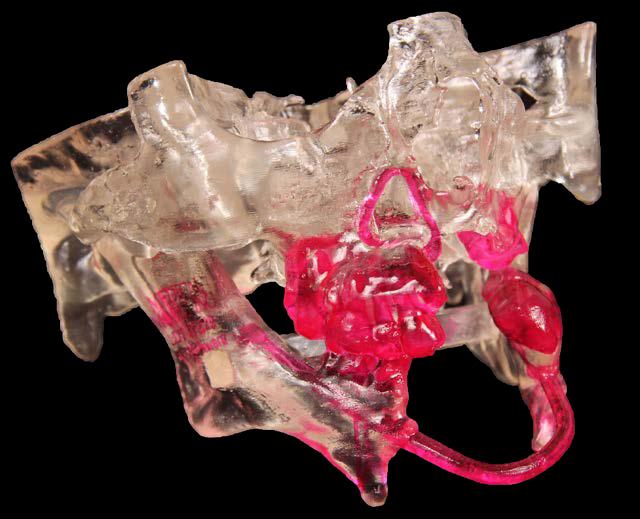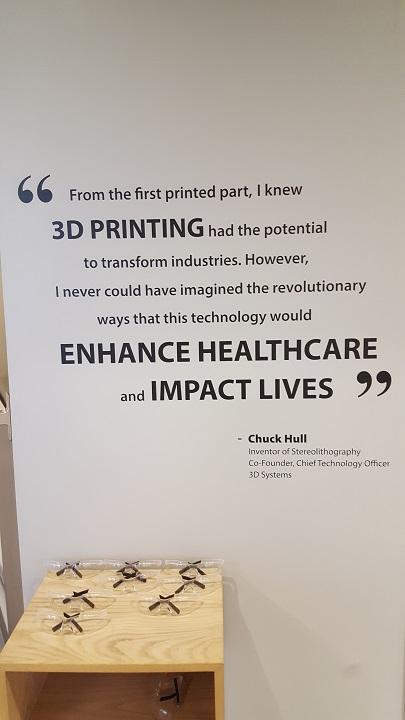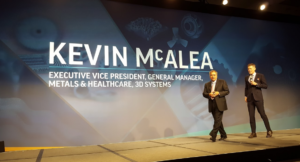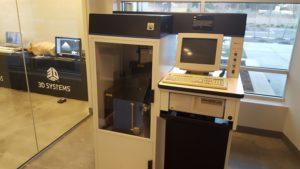Hearing about the case studies of successful surgeries and recoveries made possible thanks to 3D software and simulations, 3D printed medical models and cutting guides, and the work of the team, I was grateful for the opportunity to sit down with 3DS’ CEO, Vyomesh Joshi (VJ) and Kevin McAlea, EVP, GM, Metals and Healthcare. I had A Few Questions For these two 3DS executives to learn more about the technologies showcased in Colorado and how they fit into the company’s grander scheme.
The healthcare field represents one of 3DS’ key verticals — how does it fit into the larger scope of the company’s end-to-end approach to solutions?A key point of strategy here has been in getting the right people into position, as we talked about at IMTS; now that the people are there, how has everything been going?McAlea: “3D Systems always had good results in healthcare from early on; primarily because SLA was our core printing technology and it turned out to be very suitable for medical applications where resolution, precision, surface finish were critical. We saw early successes in hearing aids, and products like Align. These three acquisitions, in the latter half of 2014, we inherited as part of that people pursuing 3D printing-based applications in other areas. I learned how different being in manufacturing is than being in prototyping. The importance of quality and quality management systems which 3D had lacked historically; the importance of having domain experts, people who understood the regulatory issues, design issues, as a recipe for success; in the world of prototyping you can be a generalist and be successful, but in these verticals you need real focus, you need deep understanding of customer requirements, you need in some cases customized products. You need to understand their environment including regulatory environment, and support them with a full solution. We did that with healthcare, it was a learning experience for me, and as the result of that we had the kernel of an idea here that we can fit into other verticals. Other obvious verticals such as aerospace where we can take the approach and the understanding we have in healthcare and apply it successfully in new opportunities.”
VJ: “We really think through all the way to the design and complete end-to-end workflow. That’s a very important part. When people talk about vertical market, people say, oh, we’re going to have more sales people, and that’s not what you need, what you need is really understanding this end-to-end workflow and really understanding the customer and use cases that Kevin talked about. And having the ability to manufacture the part, to qualify the part, manage the part, and then help the customers in holding their hands to go through design to simulation to pilot run to scale. That was the real ‘aha!’ for me, learning from what Kevin and the team have done. Being a solutions company, as I’m defining it, not as a big software solution or something, but really a use-case-centric solutions company, we can achieve distinctive sustainable competitive advantage. When device manufacturers come to our organization, they say, you are not just a metal 3D printer company, they say, you’re really going to help us, and that’s the success in my mind.”
Kevin, how do you feel about being one of ‘the right people in the right place’?VJ: “Very good. You think about the core assets I talked about. First of all I have Chuck Hull, who is extraordinary, as the CTO. He has the vision of where we can take the technology. Kevin here, with 20+ years of experience in all of the technologies, but now with healthcare and metal, because you should think about how metal has two key verticals, healthcare and aerospace, he can really help me in building a metal business and grow substantially the healthcare business. … I think the combination of 3D Systems expertise and bringing the right skill set is what the company needed. I feel very good about the organization structure with which we can drive our plans in terms of execution. I’ve said very clearly that most of our problems were internal. Now with our team, I truly believe we can focus on execution.”
McAlea: “Great. As V just said, I’ve been in this industry a long time, I joined up in Austin, Texas in ’93. I’ve seen the industry go through a lot of ups and downs, and I do believe right now manufacturing is poised to really move forward and accelerate. That’s always been a dream in this industry, prototyping is great, it’s a good business, but to see this get into advanced manufacturing is very exciting and I think we have the technologies and the infrastructure and the team to do that. So for me, that’s very exciting.”
Can you tell me more about the focus of the three facilities: Denver/Tel Aviv/Leuven?
You talked about the purity requirements and oxygen pickups as they relate to medical applications; what makes the ProX DMP 320 uniquely suited to work with this?McAlea: “In this facility we have our virtual surgical planning services. We take incoming DICOM data, segment and create a model, do an online plan with a surgeon, and then design print guides that are sent to surgeons for use in surgery. We have a large medical device manufacturing business here, both in plastics and in metals. The metals business is growing very quickly. We utilize our own printers, although we use ebeam as well for historical legacy reasons. The nature of this business is that when a company has filed their 510K with the FDA for a certain printer, there’s no change there. We have legacy customers who can use ebeam, it’s nice, we understand competing technologies in great detail. Those are the two primary businesses here.
In Leuven, we design and optimize the metal printers and have a large medical device manufacturing business with metals that’s about the same size as the facility here in Denver. Our long-term goal is to make them mirror facilities, and we’ve already integrated things like quality management into one group, the two groups really work very closely together to develop opportunities in both Western Europe and United States.
In Tel Aviv, we design and develop the medical simulators I talked about, we have great software and talent capability there, we tap into that pool that’s available in Tel Aviv, which is really rich. Increasingly as well, we take that talent and we apply it to new opportunities across healthcare — the workflow we have here in Denver is being completely remodeled and redone by the team in Tel Aviv. We see other opportunities, augmented reality applications where a surgeon can be performing a surgery and be able to visualize a model at the same time. The talent pool we have there we think can be applied not just to their traditional virtual reality-based medical simulation applications but to a variety of other 3D printing healthcare applications as well.”
VJ: “That DICOM to Print that Kevin was talking about, we can only do that if we have the software asset, and with an asset like Denver, we can make this into a completely new opportunity.”
McAlea: “These people here are expert users, probably some of the best in the world; in Tel Aviv we have fantastic programmers, so it’s a great combination. Fantastic programmers with the right background and know-how, as well.”
VJ: “They’re also in healthcare, so they understand all the modeling. It’s a very powerful way of finding opportunities to grow.”
McAlea: “For medical applications, the grade of titanium used has very little oxygen, that’s considered essential for the application. As you process the material, there’s a tendency in a lot of machines to pick up oxygen, and you have to keep monitoring the powder and if it gets above a certain threshhold then you can’t use the powder. Of course titanium powder is extremely expensive so you don’t want to have to have to throw away powder. In our machine we’re able to recycle the powder 100% because we have low oxygen pickup, and so we end up with very high-quality parts, completely recycle the powder, which leads to very good manufacturing economics.”
Do you have any additional thoughts for us?
VJ: “I hope you see the approach we are taking. Healthcare is a showcase of our approach, where we can scale and replicate. Figure 4 is in my opinion really the first time I believe in the plastics now for production applications. I think there’s a lot of healthcare applications. I really believe the core technology we have, the approach we are taking with the core assets we have, in terms of materials applications and the product design, software, the workflow approach — and then having a real proof point in healthcare gives us tremendous confidence we will be able to build a very unique additive manufacturing solutions company.”
While it can be easy indeed to get caught up into the winds of exciting events and presentations, there’s a sense of earnestness that underlies the experience at 3D Systems’ Healthcare Technology Center. In a business like this, focused on high-tech solutions to life-changing health concerns, the team at hand are only there because they truly believe in the solutions they offer. Walking around the office on Monday, watching engineers taking calls with surgeons preparing to use these technologies in the operating room, talking with the executive team backing the efforts, getting some hands-on time with some of the technology — it all gave me a much-needed boost in mood to see some actual, very tangible good being done in the world today.
- An original SLA-1 shows how far we’ve come since the 1908s
- I am not one of the experts they spoke of with VSP technology
- A Figure 4 module operating in the lobby
Subscribe to Our Email Newsletter
Stay up-to-date on all the latest news from the 3D printing industry and receive information and offers from third party vendors.
You May Also Like
Gorilla Sports GE’s First 3D Printed Titanium Cast
How do you help a gorilla with a broken arm? Sounds like the start of a bad joke a zookeeper might tell, but it’s an actual dilemma recently faced by...
Nylon 3D Printed Parts Made More Functional with Coatings & Colors
Parts 3D printed from polyamide (PA, Nylon) 12 using powder bed fusion (PBF) are a mainstay in the additive manufacturing (AM) industry. While post-finishing processes have improved the porosity of...
$25M to Back Sintavia’s Largest Expansion of Metal 3D Printing Capacity Since 2019
Sintavia, the digital manufacturing company specializing in mission-critical parts for strategic sectors, announced a $25 million investment to increase its production capacity, the largest expansion to its operations since 2019....
Velo3D Initiates Public Offering in a Bid to Strengthen Financial Foundations and Drive Future Growth
Velo3D (NYSE: VLD) has been among a number of publicly traded 3D printing firms that have attempted to weather the current macroeconomic climate. After posting a challenging financial report for 2023,...







































